
Njord
Encyclopedia
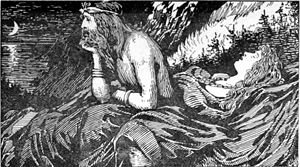
Norse mythology
Norse mythology, a subset of Germanic mythology, is the overall term for the myths, legends and beliefs about supernatural beings of Norse pagans. It flourished prior to the Christianization of Scandinavia, during the Early Middle Ages, and passed into Nordic folklore, with some aspects surviving...
, Njörðr is a god among the Vanir
Vanir
In Norse mythology, the Vanir are a group of gods associated with fertility, wisdom and the ability to see the future. The Vanir are one of two groups of gods and are the namesake of the location Vanaheimr . After the Æsir–Vanir War, the Vanir became a subgroup of the Æsir...
. Njörðr is father of the deities Freyr
Freyr
Freyr is one of the most important gods of Norse paganism. Freyr was highly associated with farming, weather and, as a phallic fertility god, Freyr "bestows peace and pleasure on mortals"...
and Freyja by his unnamed Van sister, was in an ill-fated marriage with the goddess Skaði
Skaði
In Norse mythology, Skaði is a jötunn and goddess associated with bowhunting, skiing, winter, and mountains...
, lives in Nóatún
Noatun (mythology)
In Norse mythology, Nóatún is the sea-side abode of the god Njörðr.-References:*Orchard, Andy . Dictionary of Norse Myth and Legend. Cassell. ISBN 0-304-34520-2...
and is associated with sea, seafaring, wind, fishing, wealth, and crop fertility.
Njörðr is attested in the Poetic Edda
Poetic Edda
The Poetic Edda is a collection of Old Norse poems primarily preserved in the Icelandic mediaeval manuscript Codex Regius. Along with Snorri Sturluson's Prose Edda, the Poetic Edda is the most important extant source on Norse mythology and Germanic heroic legends, and from the early 19th century...
, compiled in the 13th century from earlier traditional sources, the Prose Edda
Prose Edda
The Prose Edda, also known as the Younger Edda, Snorri's Edda or simply Edda, is an Icelandic collection of four sections interspersed with excerpts from earlier skaldic and Eddic poetry containing tales from Nordic mythology...
, written in the 13th century by Snorri Sturluson
Snorri Sturluson
Snorri Sturluson was an Icelandic historian, poet, and politician. He was twice elected lawspeaker at the Icelandic parliament, the Althing...
, in euhemerized form as a beloved mythological early king of Sweden
Sweden
Sweden , officially the Kingdom of Sweden , is a Nordic country on the Scandinavian Peninsula in Northern Europe. Sweden borders with Norway and Finland and is connected to Denmark by a bridge-tunnel across the Öresund....
in Heimskringla
Heimskringla
Heimskringla is the best known of the Old Norse kings' sagas. It was written in Old Norse in Iceland by the poet and historian Snorri Sturluson ca. 1230...
, also written by Snorri Sturluson in the 13th century, as one of three gods invoked in the 14th century Hauksbók
Hauksbók
The Hauksbók is one of the few medieval Norse manuscripts of which the author is known. His name was Haukr Erlendsson , and as long back as it is possible to trace the manuscript it has been called the Hauksbók after its author. It was partly written by Haukr himself, partly by assistants...
ring oath
Almáttki áss
Hinn almáttki áss is an unknown Norse divinity evoked in an Icelandic legal oath sworn on a temple ring. This oath is especially mentioned in Landnámabók :-Thor:...
, and in numerous Scandinavia
Scandinavia
Scandinavia is a cultural, historical and ethno-linguistic region in northern Europe that includes the three kingdoms of Denmark, Norway and Sweden, characterized by their common ethno-cultural heritage and language. Modern Norway and Sweden proper are situated on the Scandinavian Peninsula,...
n place names
Toponymy
Toponymy is the scientific study of place names , their origins, meanings, use and typology. The word "toponymy" is derived from the Greek words tópos and ónoma . Toponymy is itself a branch of onomastics, the study of names of all kinds...
. Veneration of Njörðr survived into 18th or 19th century Norwegian
Norway
Norway , officially the Kingdom of Norway, is a Nordic unitary constitutional monarchy whose territory comprises the western portion of the Scandinavian Peninsula, Jan Mayen, and the Arctic archipelago of Svalbard and Bouvet Island. Norway has a total area of and a population of about 4.9 million...
folk practice, where the god is recorded as Njor and thanked for a bountiful catch of fish.
Njörðr has been the subject of an amount of scholarly discourse and theory, often connecting him with the figure of the much earlier attested Germanic goddess Nerthus
Nerthus
In Germanic paganism, Nerthus is a goddess associated with fertility. Nerthus is attested by Tacitus, the first century AD Roman historian, in his Germania. Various theories exist regarding the goddess and her potential later traces amongst the Germanic tribes...
, the hero Hadingus
Hadingus
Hadingus was one of the earliest legendary Danish kings according to Saxo Grammaticus' Gesta Danorum where he has a detailed biography. Georges Dumézil and others have argued that Gram was partially modelled on the god Njörðr.-Gesta Danorum:...
, and theorizing on his formerly more prominent place in Norse paganism
Norse paganism
Norse paganism is the religious traditions of the Norsemen, a Germanic people living in the Nordic countries. Norse paganism is therefore a subset of Germanic paganism, which was practiced in the lands inhabited by the Germanic tribes across most of Northern and Central Europe in the Viking Age...
due to the appearance of his name in numerous place names. Njörðr is sometimes modernly anglicized
Anglicisation
Anglicisation, or anglicization , is the process of converting verbal or written elements of any other language into a form that is more comprehensible to an English speaker, or, more generally, of altering something such that it becomes English in form or character.The term most often refers to...
as Njord, Njoerd, or Njorth.
Name and eponyms
The name Njörðr corresponds to that of the older Germanic fertility goddess NerthusNerthus
In Germanic paganism, Nerthus is a goddess associated with fertility. Nerthus is attested by Tacitus, the first century AD Roman historian, in his Germania. Various theories exist regarding the goddess and her potential later traces amongst the Germanic tribes...
, and both derive from the Proto-Germanic *Nerþuz. The original meaning of the name is contested, but it may be related to the Irish word nert which means "force" and "power". It has been suggested that the change of sex from the female Nerthus to the male Njörðr is due to the fact that feminine nouns with u-stems disappeared early in Germanic language while the masculine nouns with u-stems prevailed. However, other scholars hold the change to be based not on grammatical gender but on the evolution of religious beliefs; that *Nerþuz and Njörðr appear as different genders because they are to be considered separate beings. The name Njörðr may be related to the name of the Norse goddess Njörun
Njörun
In Norse mythology, Njörun is a goddess attested in the Prose Edda, written in the 13th century by Snorri Sturluson, and various kennings . Scholarly theories have proposed that Njörun may represent the earth...
.
Njörðr's name appears in various place names in Scandinavia, such as Nærdhæwi (now Nalavi), Njærdhavi (now Mjärdevi), Nærdhælunda (now Närlunda), Nierdhatunum (now Närtuna) in Sweden, Njarðvík
Njarðvík
Njarðvík is a town in south-western Iceland located on the peninsula of Reykjanes. As of 2009, its population was 4,400.-History:In 1995 it merged with the town of Keflavík and the village of Hafnir to form the new municipality of Reykjanesbær....
in eastern Iceland, Njarðarlög and Njarðey (now Nærøy
Nærøy
Nærøy is a municipality in Nord-Trøndelag county, Norway. Nærøy is part of the Namdalen region. Norway's smallest town, Kolvereid, is the administration centre of the municipality...
) in Norway. Njörðr's name appears in a word for sponge; Njarðarvöttr (Old Norse "Njörðr's glove"). Additionally, in Old Icelandic translations of Classical
Classical antiquity
Classical antiquity is a broad term for a long period of cultural history centered on the Mediterranean Sea, comprising the interlocking civilizations of ancient Greece and ancient Rome, collectively known as the Greco-Roman world...
mythology the Roman god Saturn
Saturn (mythology)
In ancient Roman religion and myth, Saturn was a major god presiding over agriculture and the harvest time. His reign was depicted as a Golden Age of abundance and peace by many Roman authors. In medieval times he was known as the Roman god of agriculture, justice and strength. He held a sickle in...
's name is gloss
Gloss
A gloss is a brief notation of the meaning of a word or wording in a text. It may be in the language of the text, or in the reader's language if that is different....
ed as "Njörðr."
Poetic Edda
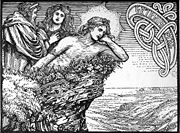
Vafþrúðnismál
In Norse mythology, Vafþrúðnismál is the third poem in the Poetic Edda. It is a conversation in verse form conducted initially between the Æsir Odin and Frigg, and subsequently between Odin and the giant Vafþrúðnir...
. In the poem, the god Odin
Odin
Odin is a major god in Norse mythology and the ruler of Asgard. Homologous with the Anglo-Saxon "Wōden" and the Old High German "Wotan", the name is descended from Proto-Germanic "*Wodanaz" or "*Wōđanaz"....
, disguised as "Gagnráðr" faces off with the wise jötunn Vafþrúðnir
Vafþrúðnir
Vafþrúðnir is a wise jötunn in Norse mythology. In the Poetic Edda poem Vafþrúðnismál, Vafþrúðnir acts as both Odin's host and opponent in a deadly battle of wits, resulting in Vafþrúðnir's defeat....
in a battle of wits. While Odin states that Vafþrúðnir knows all the fates of the gods, Odin asks Vafþrúðnir "from where Njörðr came to the sons of the Æsir," that Njörðr rules over quite a lot of temples and hörgr
Hörgr
A hörgr or hearg was a type of religious building or altar possibly consisting of a heap of stones, used in Norse paganism...
s (a type of Germanic altar), and further adds that Njörðr was not raised among the Æsir. In response, Vafþrúðnir says:
- "In Vanaheim
VanaheimrIn Norse mythology, Vanaheimr is one of the Nine Worlds and home of the Vanir, a group of gods associated with fertility, wisdom, and the ability to see the future...
the wise Powers made him- and gave him as hostage to the gods;
- at the doom of men he will come back
- home among the wise Vanir."
In stanza 16 of the poem Grímnismál
Grímnismál
Grímnismál is one of the mythological poems of the Poetic Edda. It is preserved in the Codex Regius manuscript and the AM 748 I 4to fragment. It is spoken through the voice of Grímnir, one of the many guises of the god Odin, who is tortured by King Geirröth...
, Njörðr is described as having a hall in Nóatún made for himself. The stanza describes Njörðr as a "prince of men," that he is "lacking in malice," and that he "rules over the "high-timbered temple." In stanza 43, the creation of the god Freyr's ship Skíðblaðnir
Skíðblaðnir
In Norse mythology, Skíðblaðnir is the best of ships. Skíðblaðnir is attested in the Poetic Edda, compiled in the 13th century from earlier traditional sources, and in the Prose Edda and Heimskringla, both written in the 13th century by Snorri Sturluson...
is recounted, and Freyr is cited as the son of Njörðr. In the prose introduction to the poem Skírnismál
Skírnismál
Skírnismál is one of the poems of the Poetic Edda. It is preserved in the 13th century manuscripts Codex Regius and AM 748 I 4to but may have been originally composed in heathen times...
, Freyr is mentioned as the son of Njörðr, and stanza 2 cites the goddess Skaði
Skaði
In Norse mythology, Skaði is a jötunn and goddess associated with bowhunting, skiing, winter, and mountains...
as the mother of Freyr. Further in the poem, Njörðr is again mentioned as the father of Freyr in stanzas 38, 39, and 41.
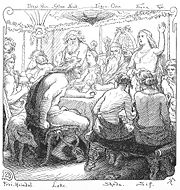
Flyting
Flyting or fliting is a contest consisting of the exchange of insults, often conducted in verse, between two parties.-Description:Flyting is a ritual, poetic exchange of insults practiced mainly between the 5th and 16th centuries. The root is the Old English word flītan meaning quarrel...
poem Lokasenna
Lokasenna
Lokasenna is one of the poems of the Poetic Edda. The poem presents flyting between the gods and Loki....
, an exchange between Njörðr and Loki
Loki
In Norse mythology, Loki or Loke is a god or jötunn . Loki is the son of Fárbauti and Laufey, and the brother of Helblindi and Býleistr. By the jötunn Angrboða, Loki is the father of Hel, the wolf Fenrir, and the world serpent Jörmungandr. By his wife Sigyn, Loki is the father of Nari or Narfi...
occurs in stanzas 33, 34, 35, and 36. After Loki has an exchange with the goddess Freyja, in stanza 33 Njörðr states:
- "That's harmless, if, beside a husband, a woman has
- a lover or someone else;
- what is surprising is a pervert god coming in here,
- who has borne children."
Loki responds in the stanza 34, stating that "from here you were sent east as hostage to the gods" (a reference to the Æsir-Vanir War) and that "the daughters of Hymir
Hymir
In Norse mythology, Hymir is a giant, husband of the giantess Hroðr and according to the Eddic poem Hymiskviða the father of the god Týr. He is the owner of a mile-wide cauldron which the Æsir wanted to brew beer in; Thor, accompanied by Týr, obtained it from him...
used you as a pisspot, and pissed in your mouth." In stanza 35, Njörðr responds that:
- "That was my reward, when I, from far away,
- was sent as a hostage to the gods,
- that I fathered that son, whom no one hates
- and is thought the prince of the Æsir
ÆsirIn Old Norse, áss is the term denoting a member of the principal pantheon in Norse paganism. This pantheon includes Odin, Frigg, Thor, Baldr and Tyr. The second pantheon comprises the Vanir...
.
Loki tells Njörðr to "stop" and "keep some moderation," and that he "won't keep it a secret any longer" that Njörðr's son Freyr was produced with his unnamed sister, "though you'd expect him to be worse than he is." The god Tyr then interjects and the flyting continues in turn.
Njörðr is referenced in stanza 22 of the poem Þrymskviða
Þrymskviða
Þrymskviða is one of the best known poems from the Poetic Edda...
, where he is referred to as the father of the goddess Freyja. In the poem, the jötunn Þrymr mistakenly thinks that he will be receiving the goddess Freyja as his bride, and while telling his fellow jötunn to spread straw on the benches in preparation for the arrival of Freyja, he refers to her as the daughter of Njörðr of Nóatún. Towards the end of the poem Sólarljóð
Sólarljóð
The Sólarljóð is an Old Norse poem, written in Iceland ca 1200. It is written in the traditional metric style of the Poetic Edda, but with a content from Christian visionary poems....
, Njörðr is cited as having nine daughters. Two of the names of these daughters are given; the eldest Ráðveig and the youngest Kreppvör.
Prose Edda
Njörðr is mentioned in the Prose Edda books GylfaginningGylfaginning
Gylfaginning, or the Tricking of Gylfi , is the first part of Snorri Sturluson's Prose Edda after Prologue. The Gylfaginning deals with the creation and destruction of the world of the Norse gods, and many other aspects of Norse mythology...
and Skáldskaparmál
Skáldskaparmál
The second part of Snorri Sturluson's Prose Edda the Skáldskaparmál or "language of poetry" is effectively a dialogue between the Norse god of the sea, Ægir and Bragi, the god of poetry, in which both Norse mythology and discourse on the nature of poetry are intertwined...
.
Gylfaginning
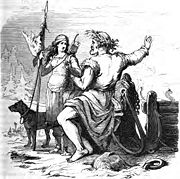
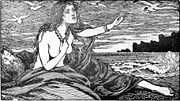
Vanaheimr
In Norse mythology, Vanaheimr is one of the Nine Worlds and home of the Vanir, a group of gods associated with fertility, wisdom, and the ability to see the future...
and is devoid of Æsir stock, and he is described as having been traded with Hœnir
Hœnir
In Norse mythology, Hœnir is one of the Æsir. He is mentioned as the one who helped Odin to create humans.- Attestations :In Ynglinga saga, along with Mímir, he went to the Vanir as a hostage to seal a truce after the Æsir-Vanir War...
in hostage exchange with between the Æsir and Vanir.
High further states that Njörðr's wife is Skaði, that she is the daughter of the jötunn Þjazi, and recounts a tale involving the two. High recalls that Skaði wanted to live in the home once owned by her father called Þrymheimr ("Thunder Home"). However, Njörðr wanted to live nearer to the sea. Subsequently, the two made an agreement that they would spend nine nights in Þrymheimr and then next three nights in Nóatún (or nine winters in Þrymheimr and another nine in Nóatún according to the Codex Regius
Codex Regius
Cōdex Rēgius is an Icelandic manuscript in which the Poetic Edda is preserved. It is made up of 45 vellum leaves, thought to have been written in the 1270s. It originally contained a further 8 leaves, which are now missing...
manuscript). However, when Njörðr returned from the mountains to Nóatún, he says:
- "Hateful for me are the mountains,
- I was not long there,
- only nine nights.
- The howling of the wolves
- sounded ugly to me
- after the song of the swans."
Skaði then responds:
- "Sleep I could not
- on the sea beds
- for the screeching of the bird.
- That gull wakes me
- when from the wide sea
- he comes each morning."
High states that afterward Skaði went back up to the mountains to Þrymheimr and recites a stanza where Skaði skis around, hunts animals with a bow, and lives in her fathers old house. Chapter 24 begins, which describes Njörðr as the father of two beautiful and powerful children: Freyr and Freyja. In chapter 37, after Freyr has spotted the beautiful jötunn Gerðr, he becomes overcome with sorrow, and refuses to sleep, drink, or talk. Njörðr then sends for Skírnir to find out who he seems to be so angry at, and, not looking forward to being treated roughly, Skírnir reluctantly goes to Freyr.
Skáldskaparmál
_from_die_helden_und_gtter_des_nordens,_oder_das_buch_der_sagen.jpg)
Skáldskaparmál
The second part of Snorri Sturluson's Prose Edda the Skáldskaparmál or "language of poetry" is effectively a dialogue between the Norse god of the sea, Ægir and Bragi, the god of poetry, in which both Norse mythology and discourse on the nature of poetry are intertwined...
within a list of 12 Æsir attending a banquet held for Ægir
Ægir
Ægir is a sea giant, god of the ocean and king of the sea creatures in Norse mythology. He is also known for hosting elaborate parties for the gods.Ægir's servants are Fimafeng and Eldir.- Description :...
. Further in Skáldskaparmál, the skald
Skald
The skald was a member of a group of poets, whose courtly poetry is associated with the courts of Scandinavian and Icelandic leaders during the Viking Age, who composed and performed renditions of aspects of what we now characterise as Old Norse poetry .The most prevalent metre of skaldic poetry is...
ic god Bragi
Bragi
Bragi is the skaldic god of poetry in Norse mythology.-Etymology:Bragi is generally associated with bragr, the Norse word for poetry. The name of the god may have been derived from bragr, or the term bragr may have been formed to describe 'what Bragi does'...
recounds the death of Skaði's father Þjazi by the Æsir. As one of the three acts of reparation performed by the Æsir for Þjazi's death, Skaði was allowed by the Æsir to choose a husband from amongst them, but given the stipulation that she may not see any part of them but their feet when making the selection. Expecting to choose the god Baldr by the beauty of the feet she selects, Skaði instead finds that she has picked Njörðr.
In chapter 6, a list of kenning
Kenning
A kenning is a type of literary trope, specifically circumlocution, in the form of a compound that employs figurative language in place of a more concrete single-word noun. Kennings are strongly associated with Old Norse and later Icelandic and Anglo-Saxon poetry...
s is provided for Njörðr: "God of chariots," "Descendant of Vanir," "a Van," father of Freyr and Freyja, and "the giving god." This is followed by an excerpt from a composition by the 11th century skald
Skald
The skald was a member of a group of poets, whose courtly poetry is associated with the courts of Scandinavian and Icelandic leaders during the Viking Age, who composed and performed renditions of aspects of what we now characterise as Old Norse poetry .The most prevalent metre of skaldic poetry is...
Þórðr Sjáreksson
Þórðr Sjáreksson
Þórðr Sjáreksson was an 11th century Icelandic skald. He composed a drápa on Þórólfr Skólmsson, four strophes of which have been preserved in the kings' sagas. He also composed a memorial drápa on Saint Óláfr Haraldsson, called Róðadrápa , one strophe of which is preserved...
, explained as containing a reference to Skaði leaving Njörðr:
- Gundrun became her son's slayer; the wise god-bride [Skadi] could not love the Van; Kialar [Odin] trained horses pretty well; Hamdir is said not to have held back sword-play.
Chapter 7 follows and provides various kennings for Freyr, including referring to him as the son of Njörðr. This is followed by an excerpt from a work by the 10th century skald Egill Skallagrímsson
Egill Skallagrímsson
Egill Skallagrímsson was a Viking Age warrior and skald. Egill is one of the great anti-heroes of the Icelandic sagas.-Life:...
that references Njörðr (here anglicized as "Niord"):
- For Freyr and Niord have endowed Griotbiorn with a power of wealth.
In chapter 20, "daughter of Njörðr" is given as a kenning for Freyja. In chapter 33, Njörðr is cited among the gods attending a banquet held by Ægir. In chapter 37, Freyja is again referred to as Njörðr's daughter in a verse by the 12th century skald Einarr Skúlason
Einarr Skúlason
Einarr Skúlason was an Icelandic priest and skald. He was the most prominent Norse poet of the 12th century.He was descended from the family of Egill Skallagrímsson, the so called Mýramenn. For most of his life he lived in Norway, with the kings Sigurðr Jórsalafari, Haraldr gilli and the sons of...
. In chapter 75, Njörðr is included in a list of the Æsir. Additionally, Njörðr is used in kennings for "warrior" or "warriors" various times in Skáldskaparmál.
Heimskringla
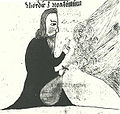
Kings' sagas
The kings' sagas are Norse sagas which tell of the lives of Scandinavian kings. They were composed in the 12th to 14th centuries in Iceland and Norway....
collected in Heimskringla; Ynglinga saga
Ynglinga saga
Ynglinga saga is a legendary saga, originally written in Old Norse by the Icelandic poet Snorri Sturluson about 1225. It was first translated into English and published in 1844....
, the Saga of Hákon the Good and the Saga of Harald Graycloak. In chapter 4 of Ynglinga saga, Njörðr is introduced in connection with the Æsir-Vanir War
Æsir-Vanir War
In Norse mythology, the Æsir–Vanir War was a war that occurred between the Æsir and the Vanir, two groups of gods. The war ultimately resulted in the unification of the two tribes into a single tribe of gods...
. When the two sides became tired of war, they came to a peace agreement and exchanged hostages. For their part, the Vanir send to the Æsir their most "outstanding men"; Njörðr, described as wealthy, and Freyr, described as his son, in exchange for the Æsir's Hœnir
Hœnir
In Norse mythology, Hœnir is one of the Æsir. He is mentioned as the one who helped Odin to create humans.- Attestations :In Ynglinga saga, along with Mímir, he went to the Vanir as a hostage to seal a truce after the Æsir-Vanir War...
. Additionally, the Æsir send Mímir
Mímir
Mímir or Mim is a figure in Norse mythology renowned for his knowledge and wisdom who is beheaded during the Æsir-Vanir War...
in exchange for the wise Kvasir
Kvasir
In Norse mythology, Kvasir was a being born of the saliva of the Æsir and the Vanir, two groups of gods. Extremely wise, Kvasir traveled far and wide, teaching and spreading knowledge. This continued until the dwarfs Fjalar and Galar killed Kvasir and drained him of his blood...
.
Further into chapter 4, Odin appoints Njörðr and Freyr as priests
Gothi
A goði or gothi is the Old Norse term for a priest and chieftain. Gyðja signifies a priestess.The name appears in Wulfila's Gothic language translation of the bible as gudja for "priest", but in Old Norse it is only the feminine form gyðja that perfectly corresponds to the Gothic form...
of sacrificial offerings
Blót
The blót was Norse pagan sacrifice to the Norse gods and the spirits of the land. The sacrifice often took the form of a sacramental meal or feast. Related religious practices were performed by other Germanic peoples, such as the pagan Anglo-Saxons...
, and they became gods among the Æsir. Freyja is introduced as a daughter of Njörðr, and as the priestess at the sacrifices. In the saga, Njörðr is described as having once wed his unnamed sister while he was still among the Vanir, and the couple produced their children Freyr and Freyja from this union, though this custom was forbidden among the Æsir.
Chapter 5 relates that Odin gave all of his temple priests dwelling places and good estates, in Njörðr's case being Nóatún
Noatun (mythology)
In Norse mythology, Nóatún is the sea-side abode of the god Njörðr.-References:*Orchard, Andy . Dictionary of Norse Myth and Legend. Cassell. ISBN 0-304-34520-2...
. Chapter 8 states that Njörðr married a woman named Skaði, though she would not have intercourse with him. Skaði then marries Odin, and the two had numerous sons.
In chapter 9, Odin dies and Njörðr takes over as ruler of the Swedes, and he continues the sacrifices. The Swedes recognize him as their king, and pay him tribute. Njörðr's rule is marked with peace and many great crops, so much so that the Swedes believed that Njörðr held power over the crops and over the prosperity of mankind. During his rule, most of the Æsir die, their bodies are burned, and sacrifices are made by men to them. Njörðr has himself "marked for" Odin and he dies in his bed. Njörðr's body is burnt by the Swedes, and they weep heavily at his tomb. After Njörðr's reign, his son Freyr replaces him, and he is greatly loved and "blessed by good seasons like his father."
In chapter 14 of Saga of Hákon the Good a description of the pagan Germanic
Germanic paganism
Germanic paganism refers to the theology and religious practices of the Germanic peoples of north-western Europe from the Iron Age until their Christianization during the Medieval period...
custom of Yule
Yule
Yule or Yuletide is a winter festival that was initially celebrated by the historical Germanic people as a pagan religious festival, though it was later absorbed into, and equated with, the Christian festival of Christmas. The festival was originally celebrated from late December to early January...
is given. Part of the description includes a series of toasts
Toast (honor)
A toast is a ritual in which a drink is taken as an expression of honor or goodwill. The term may be applied to the person or thing so honored, the drink taken, or the verbal expression accompanying the drink. Thus, a person could be "the toast of the evening," for whom someone "proposes a toast"...
. The toasts begin with Odin's toasts, described as for victory and power for the king, followed by Njörðr and Freyr's toast, intended for good harvests and peace. Following this, a beaker is drank for the king, and then a toast is given for departed kin. Chapter 28 quotes verse where the kenning "Njörðr-of-roller-horses" is used for "sailor". In the Saga of Harald Graycloak, a stanza is given of a poem entitled Vellekla ("Lack of Gold") by the 10th century Icelandic skald
Skald
The skald was a member of a group of poets, whose courtly poetry is associated with the courts of Scandinavian and Icelandic leaders during the Viking Age, who composed and performed renditions of aspects of what we now characterise as Old Norse poetry .The most prevalent metre of skaldic poetry is...
Einarr skálaglamm
Einarr Helgason
Einarr Helgason or Einarr skálaglamm was a 10th century Icelandic skald.He was a court-poet of Lord Hákon to whom he dedicated his magnum opus, the Vellekla...
that mentions Njörðr in a kenning for "warrior."
Egils saga
In chapter 80 of the 13th century Icelandic saga Egils sagaEgils saga
Egils saga is an epic Icelandic saga. The oldest transcript dates back to 1240 AD. The saga is centered on the life of Egill Skallagrímsson, an Icelandic farmer, viking and skald...
, Egill Skallagrímsson
Egill Skallagrímsson
Egill Skallagrímsson was a Viking Age warrior and skald. Egill is one of the great anti-heroes of the Icelandic sagas.-Life:...
composes a poem in praise of Arinbjörn (Arinbjarnarkviða
Arinbjarnarkviða
Arinbjarnarkviða is a skaldic poem by Egill Skalla-Grímsson in praise of his friend Arinbjörn. The poem is preserved in manuscripts of Egils saga. Some lines are lost while others may be corrupted. The metre is kviðuháttr.-References:...
). In stanza 17, Egill writes that all others watch in marvel how Arinbjörn gives out wealth, as he has been so endowed by the gods Freyr and Njörðr.
Modern folk practice
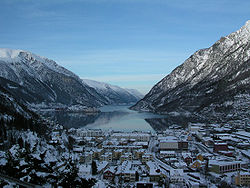
Odda
is a municipality and town in the county of Hordaland, Norway. Odda was separated from Ullensvang on 1 July 1913 and on 1 January 1964 Røldal was merged with Odda. The town of Odda is the centre of the landscape of Hardanger, located at the end of the Hardangerfjord.In 1927, Erling Johnson,...
, Hordaland
Hordaland
is a county in Norway, bordering Sogn og Fjordane, Buskerud, Telemark and Rogaland. Hordaland is the third largest county after Akershus and Oslo by population. The county administration is located in Bergen...
, Norway. The informant comments on a family tradition in which the god is thanked for a bountiful catch of fish:
- The old folk [folk in the olden days?] were always rather lucky when they went fishing. One night old Gunnhild Reinsnos (born in 1746) and Johannes Reinsnos were fishing in the Sjosavatn. They had taken a torch and were fishing with live bait. The fish bit well, and it wasn't long before Gunnhild had a week's supply of fish for her pot. So she wound her line around her rod with the words: "Thanks be to him, to Njor, for this time."
Scholar Georges Dumézil
Georges Dumézil
Georges Dumézil was a French comparative philologist best known for his analysis of sovereignty and power in Proto-Indo-European religion and society...
further cites various tales of havmennesker (Norwegian "sea people") who govern over sea weather, wealth, or, in some incidents, give magic boats are likely connected to Njörðr.
Nerthus
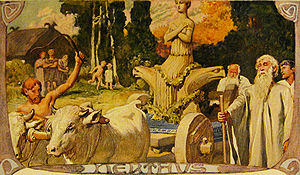
Nerthus
In Germanic paganism, Nerthus is a goddess associated with fertility. Nerthus is attested by Tacitus, the first century AD Roman historian, in his Germania. Various theories exist regarding the goddess and her potential later traces amongst the Germanic tribes...
, whose reverence by various Germanic tribes
Germanic peoples
The Germanic peoples are an Indo-European ethno-linguistic group of Northern European origin, identified by their use of the Indo-European Germanic languages which diversified out of Proto-Germanic during the Pre-Roman Iron Age.Originating about 1800 BCE from the Corded Ware Culture on the North...
is described by Roman
Roman Empire
The Roman Empire was the post-Republican period of the ancient Roman civilization, characterised by an autocratic form of government and large territorial holdings in Europe and around the Mediterranean....
historian Tacitus
Tacitus
Publius Cornelius Tacitus was a senator and a historian of the Roman Empire. The surviving portions of his two major works—the Annals and the Histories—examine the reigns of the Roman Emperors Tiberius, Claudius, Nero and those who reigned in the Year of the Four Emperors...
in his 1st CE
Common Era
Common Era ,abbreviated as CE, is an alternative designation for the calendar era originally introduced by Dionysius Exiguus in the 6th century, traditionally identified with Anno Domini .Dates before the year 1 CE are indicated by the usage of BCE, short for Before the Common Era Common Era...
century work Germania
Germania (book)
The Germania , written by Gaius Cornelius Tacitus around 98, is an ethnographic work on the Germanic tribes outside the Roman Empire.-Contents:...
. The connection between the two is due to the linguistic relationship between Njörðr and the reconstructed
Linguistic reconstruction
Linguistic reconstruction is the practice of establishing the features of the unattested ancestor of one or more given languages. There are two kinds of reconstruction. Internal reconstruction uses irregularities in a single language to make inferences about an earlier stage of that language...
*Nerþuz, "Nerthus" being the feminine, Latin
Latin
Latin is an Italic language originally spoken in Latium and Ancient Rome. It, along with most European languages, is a descendant of the ancient Proto-Indo-European language. Although it is considered a dead language, a number of scholars and members of the Christian clergy speak it fluently, and...
ized form of what Njörðr would have looked like around 1 CE. This has led to theories about the relation of the two, including that Njörðr may have once been a hermaphroditic god or, generally considered more likely, that the name may indicate an otherwise unattested divine brother and sister pair such as Freyr and Freyja. Consequently, Nerthus has been identified with Njörðr's unnamed sister with whom he had Freyja and Freyr, which is mentioned in Lokasenna.
Hadingus

Hadingus
Hadingus was one of the earliest legendary Danish kings according to Saxo Grammaticus' Gesta Danorum where he has a detailed biography. Georges Dumézil and others have argued that Gram was partially modelled on the god Njörðr.-Gesta Danorum:...
, attested in book I of Saxo Grammaticus
Saxo Grammaticus
Saxo Grammaticus also known as Saxo cognomine Longus was a Danish historian, thought to have been a secular clerk or secretary to Absalon, Archbishop of Lund, foremost advisor to Valdemar I of Denmark. He is the author of the first full history of Denmark.- Life :The Jutland Chronicle gives...
' 13th century work Gesta Danorum
Gesta Danorum
Gesta Danorum is a patriotic work of Danish history, by the 12th century author Saxo Grammaticus . It is the most ambitious literary undertaking of medieval Denmark and is an essential source for the nation's early history...
. Some of these similarities include that, in parallel to Skaði and Njörðr in Skáldskaparmál, Hadingus is chosen by his wife Regnhild after selecting him from other men at a banquet by his lower legs, and, in parallel to Skaði and Njörðr in Gylfaginning, Hadingus complains in verse of his displeasure at his life away from the sea and how he is disturbed by the howls of wolves, while his wife Regnhild complains of life at the shore and states her annoyance at the screeching sea birds. Georges Dumézil
Georges Dumézil
Georges Dumézil was a French comparative philologist best known for his analysis of sovereignty and power in Proto-Indo-European religion and society...
theorized that in the tale Hadingus passes through all three functions of his trifunctional hypothesis
Trifunctional hypothesis
The trifunctional hypothesis of prehistoric Proto-Indo-European society postulates a tripartite ideology reflected in the existence of three classes or castes—priests, warriors, and commoners —corresponding to the three functions of the sacral, the martial and the economic, respectively...
, before ending as an Odinic hero, paralleling Njörðr's passing from the Æsir to the Vanir in the Æsir-Vanir War
Æsir-Vanir War
In Norse mythology, the Æsir–Vanir War was a war that occurred between the Æsir and the Vanir, two groups of gods. The war ultimately resulted in the unification of the two tribes into a single tribe of gods...
.
Svafrþorinn
In stanza 8 of the poem FjölsvinnsmálFjölsvinnsmál
Fjölsvinnsmál or The Sayings of Fjölsvinnr is the second of two Old Norse poems commonly published under the title Svipdagsmál "The Lay of Svipdagr". These poems are found together in several 17th century paper manuscripts with Fjölsvinnsmál...
, Svafrþorinn
Svafrþorinn
In Norse mythology, Svafrþorinn is the father of Menglöð by an unnamed mother, and is attested solely in a stanza of Fjölsvinnsmál. As this is the only mention of the figure, further information has been theorized from the potential etymologies of the name Svafrþorinn and his relation to...
is stated as the father of Menglöð by an unnamed mother, who the hero Svipdagr seeks. Menglöð has often been theorized as the goddess Freyja, and according to this theory, Svafrþorinn would therefore be Njörðr. The theory is complicated by the etymology of the name Svafrþorinn (þorinn meaning "brave" and svafr means "gossip") (or possibly connects to sofa "sleep"), which Rudolf Simek
Rudolf Simek
Rudolf Simek is an Austrian Germanist and Philologian.Simek studied German literature, philosophy and Catholic theology in the University of Vienna, before becoming a librarian and a docent at the institution. He taught among others in the universities of Edinburgh, Tromsø and Sydney...
says makes little sense when attempting to connect it to Njörðr.
Modern influence
Njörðr has been the subject of an amount of artistic depictions. Depictions include "Freyr und Gerda; Skade und Niurd" (drawing, 1883) by K. Ehrenberg, "Njörðr" (1893) by Carl Frederick von SaltzaCarl Frederick von Saltza
Carl Fredrik von Saltza was an artist and portrait painter. Saltza was best known in Sweden for his genre pictures in watercolor and for his drawings. He was one of the main illustrators for Fredrik Sander's 1893 edition of the Poetic Edda...
, "Skadi" (1901) by E. Doepler d. J., and "Njörd's desire of the Sea" (1908) by W. G. Collingwood
W. G. Collingwood
William Gershom Collingwood, was an author, artist, antiquary and Professor of Fine Arts at Reading University....
.

